3rd Coimbra Biennial of Contemporary Art – Anozero’19 The Third Bank
Que río és éste
por el cual corre el Ganges?
Jorge Luis Borges, “Heráclito”
[…] at first, with the coming of the first floods on the river
and the unrelenting rains,
we all feared the world was ending […]
João Guimarães Rosa, “The Third Bank of the River”
Poetry, first of all
There is something poetic in a city cut through by a river, like the imperturbable flow of the Mondego between the banks from which Coimbra sprawls. The river is the image of continuity and impermanence, its time a tangent to infinity. Our existences, as fleeting as the people who cross it, the bridges that cut across it and the waters that pass through it, are the height of discontinuity; our time is minuscule compared to the river.
The Mondego’s relationship with Coimbra has changed over time: for centuries, the city occupied the right bank almost exclusively, the side of the old centre and the University, uplifted to World Heritage status in 2013. Since then, the University, until recently an exclusively male and religious institution, has moved from Rua da Sofia to the Alta, where, as a Eurocentric hub of knowledge production, it has spread. With its spatial organization a model of urban and cultural planning, a broadcaster and imposer of European and Portuguese values, it spread throughout the world and took root in the former Portuguese colonies.
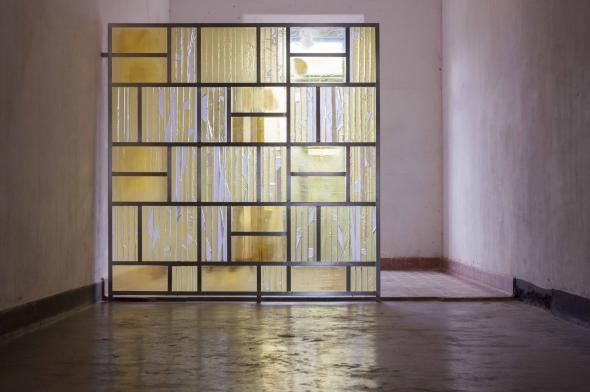 Belén Uriel
Belén Uriel
The convent dedicated to Santa Clara, founder of the female branch of the Franciscan order, was established on the left bank of the Mondego in the early 14th century. Due to its proximity to the river and the successive flooding, the building had to be raised to the point where an upper floor needed to be built. But the insistence of the waters of the long shores forced the Poor Clares who were enclosed there to leave the old convent and find refuge on Monte da Esperança, where the Santa Clara-a-Nova Convent is situated today, and has been since the 17th century.
Both with high seats, the two institutions today regard each other. Below them flows the river, reiterating the emptiness of our constructions, solid or abstract. The Convent was abandoned until art claimed it, and the Mondego, as its axis and both geographical and symbolic, led the biennial to the story “The Third Bank of the River”, the intriguing tale that João Guimarães Rosa published in 1962.
The story tells the story of a father, narrated by his son. The father lives in a village by the river but decides to have a canoe built, just large enough for one person, get into it and never leave it again, forever remaining downriver, upriver. This self-exclusion under the open sky, a personal decision by the protagonist for which he offers no explanation to either family or community, constitutes an extreme gesture of irreversible occupation. It is this gesture that defines the territory, tremendous, unstable, unfathomable and unspeakable, of the third bank that is our modernity.
The Third Bank of the River
In “The Third Bank of the River”, the family – father, mother and three children – is fundamentally and permanently altered by the departure of the father, and silence enters as one of the protagonists: Father said nothing. Our house was closer to the river then than it is now, less than a quarter of a league away: there rolled the river, great, deep and silent always silent. Father and river share a possible understanding of silence and move quietly through the whole story. The narrator incessantly seeks his father’s gaze and voice, finding parenthesis in its place: Father left his answer in suspense. Silence as an encapsulation of being, an inner place of recollection, a cause of deep external upheaval; it is understood as taking a stance and as an instrument of language.
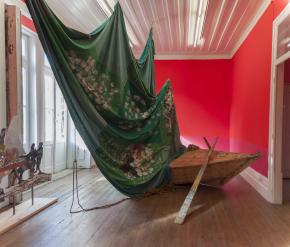 Anna BoghiguianThe desertion of the father figure triggers a range of family reactions: tension, death, mourning, and faith. All this comes as a result of the invention of a new means of being. Our father never came back. He hadn’t gone anywhere. He stuck to that stretch of the river, staying halfway across, always in the canoe, never to spring out of it, ever again. From that moment on, the family is ruled by the mother. The complexity and inward nature of interpersonal relationships that explore the ambivalent and dysfunctional nature of family bonds, both comforting and oppressive, come to light. These relationships remain unfinished, chilled to the point of cracking. The father, whose decision is was to withdraw and merge mysteriously with the river, watches from a distance, a marginal figure. In contrast with the normative nature of the riverbanks where the others are to be found, the father creates, invents, a metaphysical bank that only he knows.
Anna BoghiguianThe desertion of the father figure triggers a range of family reactions: tension, death, mourning, and faith. All this comes as a result of the invention of a new means of being. Our father never came back. He hadn’t gone anywhere. He stuck to that stretch of the river, staying halfway across, always in the canoe, never to spring out of it, ever again. From that moment on, the family is ruled by the mother. The complexity and inward nature of interpersonal relationships that explore the ambivalent and dysfunctional nature of family bonds, both comforting and oppressive, come to light. These relationships remain unfinished, chilled to the point of cracking. The father, whose decision is was to withdraw and merge mysteriously with the river, watches from a distance, a marginal figure. In contrast with the normative nature of the riverbanks where the others are to be found, the father creates, invents, a metaphysical bank that only he knows.
Marginality amid the banks.
Rather than naturally aging like the others, the figure of the father, with the effect of the elements – floods, rain, scorching sun, cold, wind, night, dark, hunger, nakedness – is changed and transformed into an animal. This is what the son concludes, as he imagines the suffering of his father and suffers with him, while becoming more and more like him: someone who knew us would remark that I was getting to look more and more like my father. There is a symmetry between the condition of the two – the one on the bank, inhabiting it placidly, and the one on the bank beyond the river banks. The son, inextricably linked to the masculine, animalized father figure, is a character, both free from and imprisoned by his father, growing old in a life where he can but wait and postpone the inevitable.
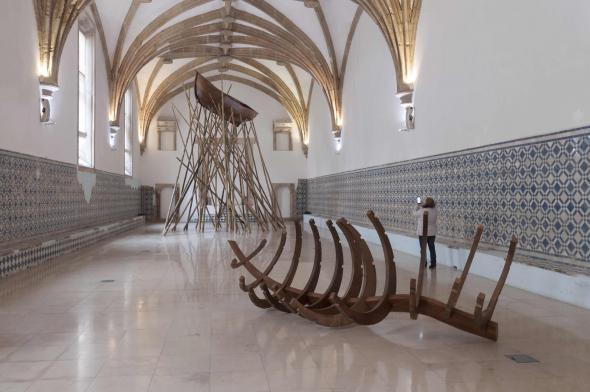 José Spaniol
José Spaniol
While the unwavering determination of this collective father suffers from militant existentialism, he also has irreducible faith: a kind of holy man, moved by a resolute purpose; an anchorite who, instead of rising above the common space, stays floating in the river/time. This is evidenced in the ritual repetition of the word father, our father… our father, like a litany, a prayer of enchantment based on the use of linguistic triads like “down the river, lost in the river, inside the river”, “dutiful, orderly, straightforward”, “great deep and silent”. The narrative also offers other liturgical aspects: [They] lighted bonfires on the riverbank, and in their glare, prayed and called out to Father. The river side and the relationship with the waters are configured as altars of worship of he who is present only in memory. The canoe, the father’s coffin, becomes the elusive altar to which offerings are presented: I held up the things to eat, and then laid them in a hollowed-out rock in the river bluff, safe from any animals that might nose around and where they would be kept dry in rain or dew. Time after time, day after day I did the same thing.
Passage – the sum-protagonist – of interior life and the chance of exterior life.
An inhabitant from far away, beyond being seen, as he wandered up and down on the river in the wilderness, the character of the father loses his materiality and becomes a mere spectre, a ghost, a psychopomp. We never talked about him either. We only thought of him. Father could never be forgotten; and if for short periods of time we pretended to ourselves that we had forgotten, it was only to find ourselves roused suddenly by his memory, startled by it again and again. With the passage of time, a whole lifetime spent, these presences lose their solidity, their boundaries weakening and crumbling, leaving just waste, rags of memories, ever more fluid and diffuse. Near the end, we witness the recognition of the son by the father, the effective acknowledgement of the evocation made from the bank, but the narrator’s sudden recoil prevents the encounter from becoming fulfilled; the retreat of his being betrays the human condition itself.
A biennial for contemporary art
A river does not have first bank and a second bank: it has two. What then can be said about a third? This is the one which is not present, which has a suspended life: it is the bank formed by the jagged line of human life, where one end sticks to the other, like another wide bank formed by the fragmented parts of the fragile stuff of our bodies. In truth, it is less through our bodies and more with language, the images and objects that we produce, that we dare to weave ourselves into eternity, seeking to be the river.
Art meets the idea of revising and re-presenting what was thought was known; seeing it from another, unsuspected angle. Jorge Luis Borges goes so far as to say that all existing books may be versions of the same book, the Bible. Giambattista Vico writes that we only understand our ancestors because they were moved by the same feelings that inhabit us. Some impulses repeat, some images are re-viewed, and this may often produce invention – wasn’t it thus with Newton’s prosaic apple?
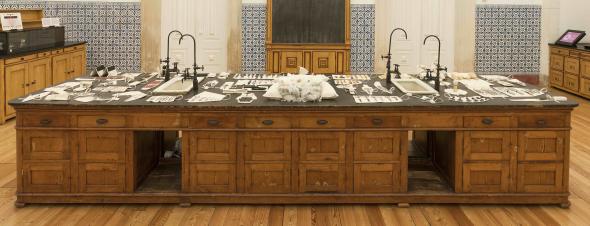 Bruno Zhu
Bruno Zhu
Contemporary art is the furthest bank, the third bank of our sensitivity and expression. That it takes place in a city like Coimbra is like an antidote to its consecration as World Heritage, as this may suggest to the unsuspecting that the city has stopped. Quite the opposite. It is what it is because of the restless spirit of those who built it, and also of the daring of those who carry on building today.
If the concept is expanded and literature used as a strategy for reinforcing the multidisciplinary nature of culture, Guimarães Rosa’s “third bank” may well be a reference to the state of general suspension which we live in, the instability seen in the crowds building up at the borders of countries and in the cities that form them, in the tense debate between those who foretell disasters and those who just shrug; the open opportunity to redefine identities of the whole order, squaring off against those whose reaction is to hold tight to the buoys of tradition. In light of the poetics of one of the greatest Brazilian authors of the 20th century, the 3rd edition of the Coimbra Biennial of Contemporary Art aims to show historical works together with those built on contemporaneity, on dreams and nightmares that acknowledge this existential crisis and yet allow it to keep flowing.
We live in disturbing times, run through with uncertainty. It remains for us to ask questions, as the answers, however excessive and pregnant with certainty they may be, do not have the measure of this world. Hence our commitment to art, in this Biennial, mostly installed in the Santa Clara-a-Nova Convent, which this winter, for the second time, will be illuminated for a few hours of the night, looming in tandem with the University; while the Mondego, as always, will follow its path, roll[ing] … great, deep and silent, always silent. The river itself runs through the building: Rosian monks or Poor Clare recluses, cloistered on the open river with the monastery’s architecture as the confining bank.
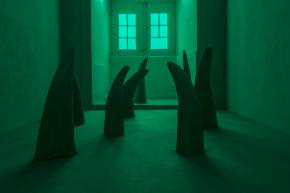 Maraiana Caló e Francisco Queimadela
Maraiana Caló e Francisco Queimadela
A Terceira Margem/The Third Bank
A Terceira Margem/The Third Bank has a tripartite curatorship and unfolds in three equally important parts: an exhibition, a book, and an activation programme. Each of these project bridges was developed by a multiplicity of voices: curators, artists, authors and students. Five theme-phrases taken from the Rosa’s story serve as the conceptual axis for the unfolding of these three parts. They suggest silence – father said nothing; marginality – travellers along the river and people living near the bank; invention – put his invention to use; militancy – muster courage; and passage – beyond the possibility of seeing or being seen.
The exhibition features works by 39 artists, half of whom are commissioned, and occupies various places in the city, fully activating its architectural and intangible heritage. In addition to occupying the spectacular Santa Clara-a-Nova Convent, the biennial extends into the city centre streets (Edifício Chiado, Sala da Cidade and Avenida Cinema), the buildings of the University of Coimbra (Colégio das Artes and Museum of Science – Laboratório Chimico and Natural History Gallery) and the venues of the Círculo de Artes Plásticas de Coimbra (CAPC Headquarters and Sereia).
The activation programme is carried out by the students of the Master’s in Curatorial Studies of the Colégio das Artes, University of Coimbra in collaboration with Esfera CAPC. Its aim is to foment dialogue and encounters between the biennial and the various local communities. This programme strengthens Anozero’s bond with the city, its residents and the university, provides students with in-context training and ensures laboratory activation of its exhibition content.
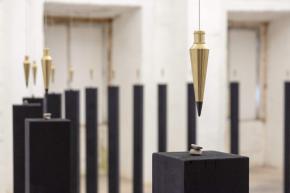 Luis Felipe OrtegaThe book brings together essays by the participating artists specifically created following the editorial format. They include visual or literary essays, that serve as a foretaste, continuation, unfolding or experimental expansion of the works exhibited; to these are added texts by Peter Pál Pelbart, Clara Rowland, Isabel Carvalho, João Paulo Borges Coelho, and Samuel Titan Júnior.
Luis Felipe OrtegaThe book brings together essays by the participating artists specifically created following the editorial format. They include visual or literary essays, that serve as a foretaste, continuation, unfolding or experimental expansion of the works exhibited; to these are added texts by Peter Pál Pelbart, Clara Rowland, Isabel Carvalho, João Paulo Borges Coelho, and Samuel Titan Júnior.
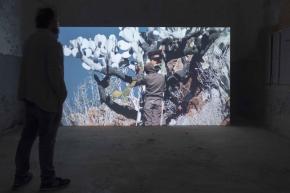 Julius von BismarckSpringing from and growing around the relations between Portuguese and Brazilian visual, concrete and experimental poetry, the biennial also includes the exhibition ShipShape, which, with the parallel curatorship of the participating artist Tomás Cunha Ferreira, presents a central core of works in which parentheses (punctuation marks, spatial and linguistic notation, on and off the page) play a major role. “I can play both sides of the street, and maybe even the third”: the exhibition echoes the words of Lou Reed, which seem to outline a possible image for defining visual poetry – neither painting nor writing, but a third (im)possibility between or beyond either.
Julius von BismarckSpringing from and growing around the relations between Portuguese and Brazilian visual, concrete and experimental poetry, the biennial also includes the exhibition ShipShape, which, with the parallel curatorship of the participating artist Tomás Cunha Ferreira, presents a central core of works in which parentheses (punctuation marks, spatial and linguistic notation, on and off the page) play a major role. “I can play both sides of the street, and maybe even the third”: the exhibition echoes the words of Lou Reed, which seem to outline a possible image for defining visual poetry – neither painting nor writing, but a third (im)possibility between or beyond either.
Fotografias de Jorge Neves